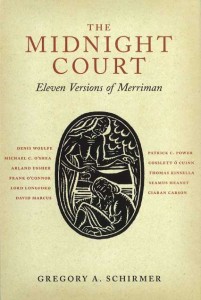The Midnight Court: eleven versions of Merriman
Published in Book Reviews, Issue 2 (March/April 2016), Reviews, Volume 24GREGORY A. SCHIRMER
Lilliput Press
€40
ISBN 9781843516392
Reviewed by Máirín Ní Dhonnchadha

Brian Merriman’s poem Cúirt an Mheon-Oíche, composed in or around 1780, is often described as the best narrative poem in Modern Irish, and even as the finest Modern Irish poem tout court. The definitive edition, by Liam P. Ó Murchú, based on what is very likely Merriman’s autograph copy, has 1,026 lines. Copies of the poem, in whole or in part, survive in more than 100 other manuscripts.
The opening lines conjure up a scene of drowsy peace on the shore of Lough Graney in east Clare, onto which bursts a horrifying, colossal woman-bailiff who sweeps Merriman off to a ‘midnight court’ in nearby Feakle, presided over by Aoibheall, the fairy queen of Thomond. Merriman listens as a young woman complains to the court of her difficulties in finding a desirable husband; an enraged old cuckold accuses her and all women of venality towards men and argues for the abolition of marriage, to which she responds with an eloquent statement of the wrongs done to human sexuality, women’s in particular, by late marriages and the enforced celibacy of Catholic priests. Merriman is then arraigned as an exemplar of all the able-bodied Irish males whose reluctance to mate has caused pandemic sexual frustration among women. Aoibheall pronounces him guilty, but just as he is about to be flayed alive he awakes out of what transpires to have been only a dream.
Formally, the poem is a stunning achievement, its exuberantly descriptive language marshalled into rhyming couplets with four assonantal stresses per line that still follow the cadences of ordinary speech. Its comic genius is most easily appreciated by hearing it spoken. Consisting largely of dramatic monologues, its court setting gestures towards the cúirteanna éigse frequented by the Gaelic poets but also towards the manor courts and quarter sessions, richly burlesqued in forms such as the barántas (mock warrant) and the dearbhú (mock affirmation on oath). An important aspect of the Cúirt is its parodying of the jaded genre of the aisling, but its most original feature is its radical engagement with Enlightenment ideas about human nature, something that is utterly atypical of late eighteenth-century Gaelic poetry. Instantly popular, it might have spearheaded the rise of a new mentality among Gaelic writers were it not for the tragic losses of the nineteenth century.
The poem remained salient in large part owing to its translators, whose work now stretches back over some 200 years. Gregory Schirmer provides a stimulating account of eleven key translations into English by Irish writers, including Frank O’Connor, Thomas Kinsella, Seamus Heaney and Ciaran Carson. It begins with the earliest, by Clareman Denis Woulfe, a contemporary if not an acquaintance of Merriman’s, and ends with Ciaran Carson’s. The eleven translations span the shift from Gaelic manuscript to print culture, and from a predominantly Irish-speaking to an English-speaking society. Woulfe’s translation, apparently dating from the early 1800s, is extant in four manuscripts. The next translation, which appeared almost a century later, was done for the printed page and far from County Clare: it was by Michael C. O’Shea, a successful Irish emigrant, who had it published in Boston in 1897. His translation was facilitated by the first appearance in print of the Irish poem, published by John O’Daly in Dublin in the 1860s or ’70s.
In eleven separate chapters, Schirmer discusses the processes employed by the different translators. While formal issues are considered, an attempt to define each trans-lation by reference to the politics of the translator and thereby unfold a story of cultural change dominates, particularly in regard to the earlier translators. The tendentious subtitle of the chapter on Arland Ussher’s translation, ‘On Behalf of the Ascendancy and Liberal Humanism’, does not sit well with Ussher’s independent-mindedness (‘I have never been able to associate myself completely with any Irish or Anglo-Irish group . . .’) or the fact that the Cúirt itself is liberal humanist to the core. The chapter discussing Coslett Ó Cuinn’s translation is subtitled ‘The Footprint of Sectarianism’. The claim that ‘wholly invented passages attacking the Catholic Church are inserted at will’ into his translation is simply untrue and would have this committed eucumenist turning in his grave. Schirmer is more compelling on the later translations, especially the very best: those by Frank O’Connor and Ciaran Carson.
Pages 111–171 provide a reprint of Risteard Ó Foghludha’s edition of 1912, and a ‘literal translation’ thereof by Schirmer. Serious errors abound in the latter, pointing to over-reliance on dictionaries, glossaries and editors’ notes. For example, the couplet ‘An gabhal gan gotha ná an gola gan geall suilt, / An toll gan toradh ná na tormach fallsa’ (lines 893–4) is rendered as ‘The groin without a spear or the penal orifice without promise of pleasure, / The hole without issue or the false swelling’. Here, gotha ‘vigour’ has been confused with gath ‘spear’, and gula has been misunderstood. True, Dineen’s Dictionary explains this instance of gola as orificium ‘penis’, but the context implies ‘female gully’, a more obvious site of pleasure than the eye of the penis. The four synedochisms identify the types who are not to be conscripted into marriage: ‘The crotch without life and the gulley that promises no pleasure, / the side that bears no fruit and the false pregnancy’.
Nevertheless, Schirmer’s book is of great value in keeping Merriman and his translators in view, and in recalling the reader to one of the masterpieces of Irish literary tradition.
Máirín Ní Dhonnchadha is Professor of Old and Middle Irish at NUI Galway.
















